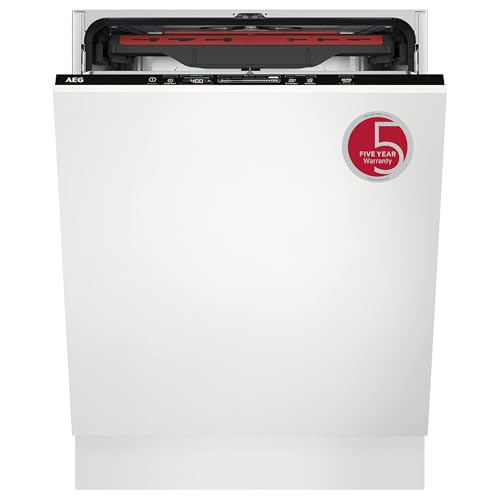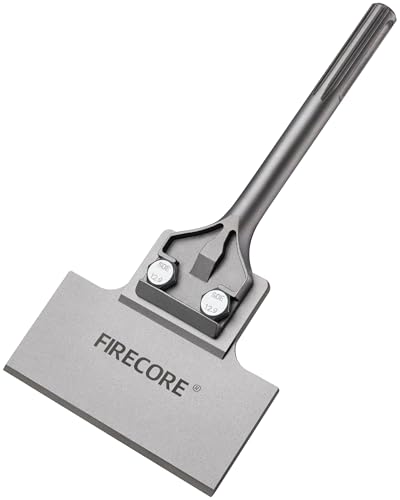




Cleaning a freestanding bath can be a challenging task, especially if you’re not sure where to start. However, with the right tools and techniques, you can keep your bath looking spotless and pristine. In this article, we will share some easy and effective tips on how to clean around a freestanding bath.
Firstly, it’s important to gather the necessary cleaning supplies. You will need a gentle cleanser, a soft sponge or cloth, a scrub brush, and a bucket of warm water. Avoid using harsh chemicals or abrasive cleaners as they can damage the surface of your bath.
Next, start by filling the bucket with warm water and adding a small amount of the cleanser. Dip your sponge or cloth into the soapy water and gently wipe down the exterior of the bath. Be sure to remove any dust, dirt, or grime that may have accumulated.
Once the exterior is clean, focus on the interior of the bath. Use a soft sponge or cloth to wipe down the sides and bottom of the bath. For any stubborn stains or marks, you can use a scrub brush to gently scrub the affected area. Be cautious not to apply too much pressure to avoid scratching the surface of the bath.
Lastly, don’t forget to rinse off any soap residue. Fill the bucket with clean water and use a fresh sponge or cloth to wipe down the entire bath, both inside and out. This will ensure that no cleaning products are left behind, leaving your freestanding bath sparkling clean and ready to use.
Best Methods for Cleaning a Freestanding Bath
1. Regular Cleaning Routine
Cleaning your freestanding bath regularly is crucial to maintain its cleanliness and prevent the build-up of dirt and grime. Here are some essential steps to include in your cleaning routine:
- Fill the bath with warm water and add a small amount of mild liquid soap or bath cleaner.
- Use a soft non-abrasive cloth or sponge to scrub the surface of the bath, paying special attention to any stains or marks.
- Rinse the bath thoroughly with clean water.
- Dry the bath with a soft towel to prevent water spots.
2. Removing Stains
Stains on a freestanding bath can be stubborn and hard to remove. Here are some effective methods for tackling different types of stains:
- Mineral Stains: Mix equal parts of white vinegar and water. Apply the solution to the stained area and let it sit for a few minutes. Scrub with a soft cloth or sponge and rinse thoroughly.
- Mildew Stains: Create a paste by mixing baking soda and water. Apply the paste to the stained area and scrub gently with a sponge or brush. Rinse well with water.
- Soap Scum: Use a mixture of white vinegar and dish soap. Apply the mixture to the affected area and let it sit for a few minutes. Scrub with a sponge or cloth and rinse thoroughly.
3. Preventing Scratches
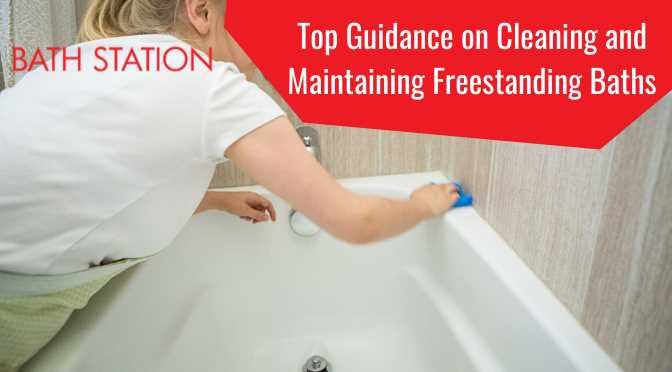
To keep your freestanding bath looking its best, it’s important to prevent scratches and damage to the surface. Here are some tips to follow:
- Use non-abrasive cleaning tools, such as soft cloths or sponges, to avoid scratching the bath surface.
- Avoid using harsh chemical cleaners or abrasive scrubbing pads.
- Place a rubber mat or towel on the bottom of the bath before adding any heavy objects to prevent scratches.
4. Professional Cleaning
If your freestanding bath requires a deep and thorough cleaning, it may be beneficial to hire a professional cleaning service. They have the expertise and specialized equipment to effectively clean and sanitize your bath, ensuring it looks its best.
5. Regular Maintenance
In addition to regular cleaning, it’s important to perform regular maintenance on your freestanding bath to prolong its lifespan. This includes checking for any leaks, repairing any cracks or chips, and resealing the bath if necessary.
| Step | Description |
|---|---|
| Regular Cleaning Routine | Clean the bath with mild soap and water regularly. |
| Removing Stains | Use specific methods for mineral stains, mildew stains, and soap scum. |
| Preventing Scratches | Avoid using abrasive tools and place a mat or towel at the bottom. |
| Professional Cleaning | Hire a professional cleaning service for deep cleaning. |
| Regular Maintenance | Check for leaks, repair cracks or chips, and reseal the bath if necessary. |
Achieve Sparkling Clean Results
When it comes to cleaning your freestanding bath, there are a few simple tips that can help you achieve sparkling clean results. Whether your bath is made of acrylic, porcelain, or another material, these tips can be used to keep it looking its best.
1. Gather Your Supplies
Before you begin cleaning, gather all the necessary supplies. This may include a gentle cleaner suitable for your bath’s material, a sponge or cloth, a soft-bristled brush, and a towel for drying.
2. Start with Gentle Cleaning
Begin by filling the bath with warm water and adding a small amount of the gentle cleaner. Use a sponge or cloth to wipe down the surfaces of the bath, paying particular attention to any areas with soap scum or stains.
3. Remove Stubborn Stains
If there are any stubborn stains, use a soft-bristled brush to gently scrub the affected area. Avoid using abrasive cleaners or tools that could damage the surface of the bath.
4. Rinse Thoroughly
After cleaning, thoroughly rinse the bath with warm water to remove any traces of cleaner or residue. This will help prevent any potential skin irritation or damage to the bath’s surface.
5. Dry Completely
Once the bath is rinsed, use a clean towel to dry the surfaces completely. This will prevent water spots and keep the bath looking shiny and clean.
6. Regular Maintenance
To keep your freestanding bath looking its best, it’s important to perform regular maintenance. This includes wiping down the surfaces after each use, using a mild cleaner regularly, and avoiding harsh chemicals or abrasive tools.
By following these simple tips, you can achieve sparkling clean results when cleaning around your freestanding bath. Regular maintenance and gentle cleaning will help keep your bath looking beautiful for years to come.
Step-by-Step Guide to Cleaning a Freestanding Bath
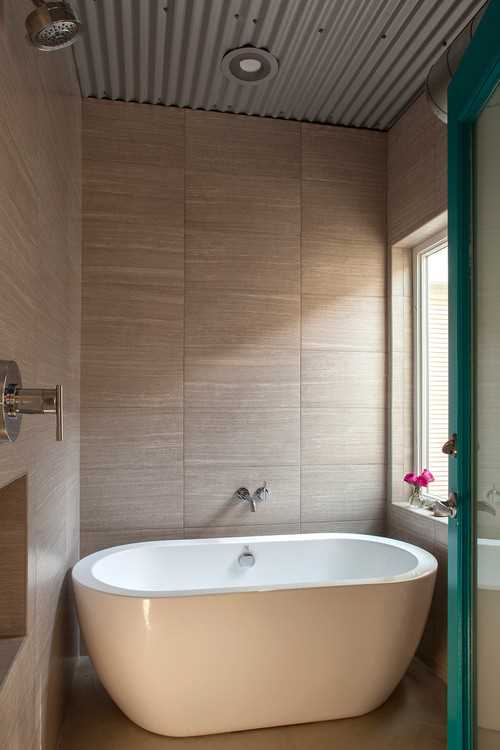
1. Gather the necessary cleaning supplies:
- Bathroom cleaner or mild soap
- Soft cloth or sponge
- Scrub brush or non-abrasive cleaning pad
- Vinegar or lemon juice (optional)
2. Drain the bath and remove any items:

Make sure the freestanding bath is completely empty and remove any bath mats, bottles, or other items that may be on or near the bath.
3. Wet the soft cloth or sponge:
Thoroughly wet a soft cloth or sponge with warm water.
4. Apply the bathroom cleaner or mild soap:
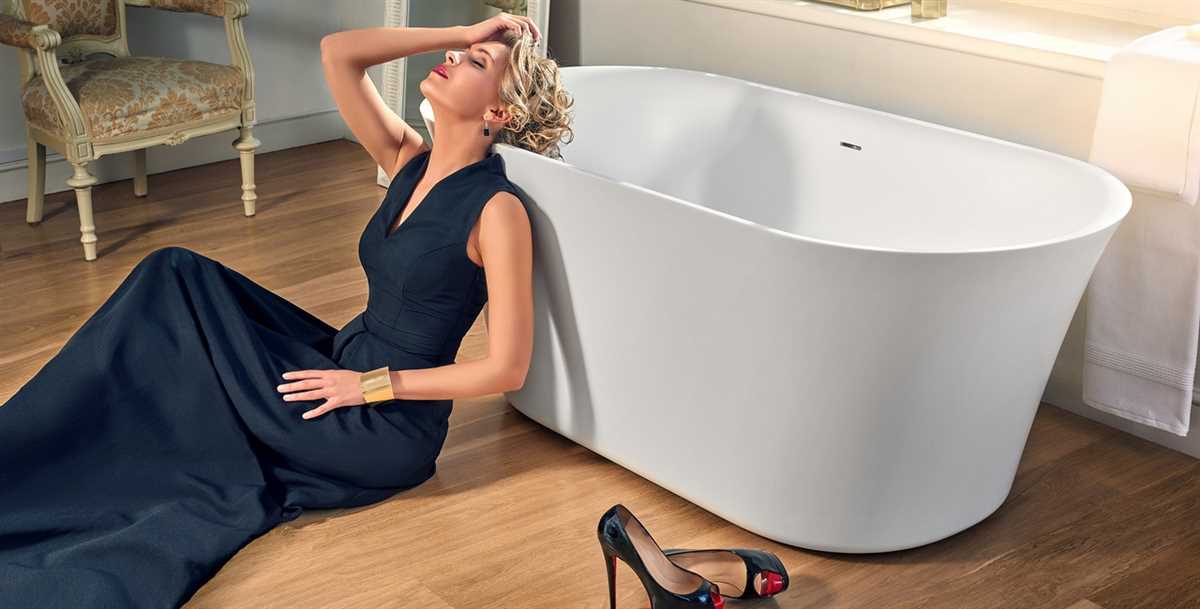
Apply a small amount of bathroom cleaner or mild soap onto the wet cloth or sponge. Alternatively, you can use a mixture of vinegar or lemon juice diluted with water for a natural cleaning solution.
5. Gently clean the surface of the freestanding bath:
Using the cloth or sponge, gently clean the entire surface of the freestanding bath. Pay special attention to any areas with stains or buildup. Use a scrub brush or non-abrasive cleaning pad for tougher stains, if necessary.
6. Rinse the bath:
Rinse the bath thoroughly with warm water to remove any remaining cleaning solution.
7. Dry the bath:
Use a dry cloth or towel to dry the surface of the freestanding bath. Make sure to dry it completely to prevent any water spots or streaks.
8. Clean the bath fixtures:
Use the same cleaning solution to clean the bath fixtures, such as faucets and handles. Wipe them down with the cloth or sponge and rinse with warm water.
9. Clean the bath drain:
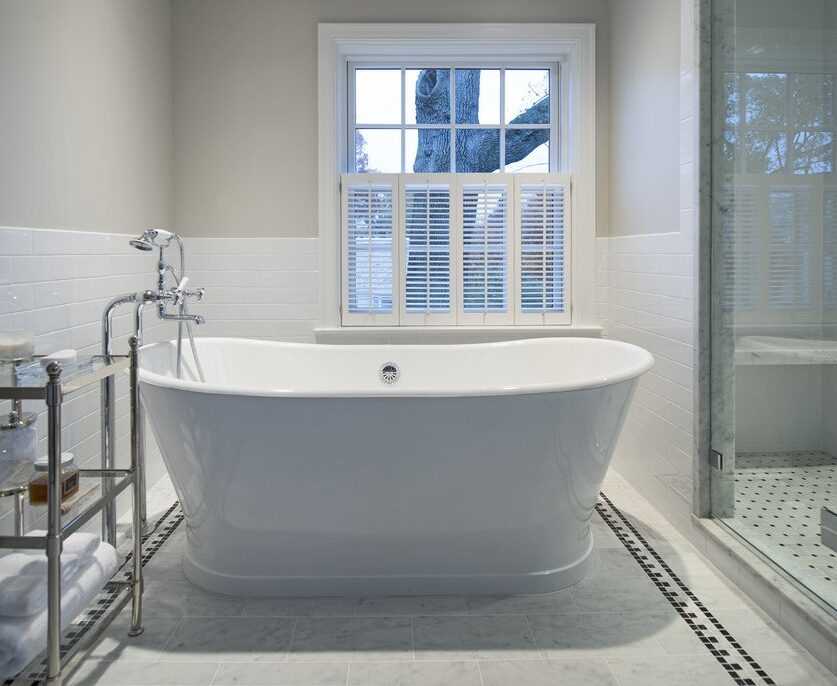
Remove any hair or debris from the bath drain using your fingers or a drain cleaning tool. Rinse the drain with hot water to remove any remaining residue.
10. Maintain regular cleaning:
To keep your freestanding bath clean, make sure to regularly clean it using the same steps. This will help prevent any buildup or stains from forming.
By following this step-by-step guide, you can effectively clean your freestanding bath and keep it looking fresh and sparkling.
Clear the Clutter and Refresh Your Space
1. Decluttering
One of the first steps in refreshing your space is to declutter. Remove any unnecessary items that may be taking up space around your freestanding bath. This can include old toiletries, towels, or decor that no longer serves a purpose. Decluttering will instantly make your space feel cleaner and more organized.
2. Deep Cleaning
After decluttering, it’s time to deep clean your freestanding bath and the surrounding area. Start by wiping down the bath with a suitable cleaning solution, paying special attention to any built-up soap scum or grime. Use a soft cloth or sponge to clean the surfaces thoroughly. Don’t forget to clean the taps, fixtures, and drains as well.
3. Organizing
Once your freestanding bath is clean, it’s important to organize the space to maximize efficiency. Consider purchasing storage solutions such as baskets or shelving units to keep your essentials within easy reach. Arrange your toiletries, towels, and other necessities neatly to avoid cluttering the space.
4. Regular Maintenance
To prevent future build-up and to ensure your freestanding bath remains clean, it’s important to establish a regular cleaning routine. Wipe down the bath after each use to remove any soap or residue. Additionally, regularly clean the surrounding area to prevent dust and dirt from accumulating.
5. Fresh Scents
A final touch to refresh your space is to add a fresh scent. Consider using scented candles or diffusers to create a calming atmosphere in your bathroom. Choose scents that you find relaxing or invigorating to enhance the overall ambiance of the space.
Conclusion

By following these easy and effective tips, you can clear the clutter and refresh your space around a freestanding bath. Remember to regularly declutter, deep clean, and organize the area to maintain a clean and inviting bathroom. Adding a touch of fragrance will provide an extra sense of relaxation and serenity.
Essential Tools and Products for Freestanding Bath Cleaning
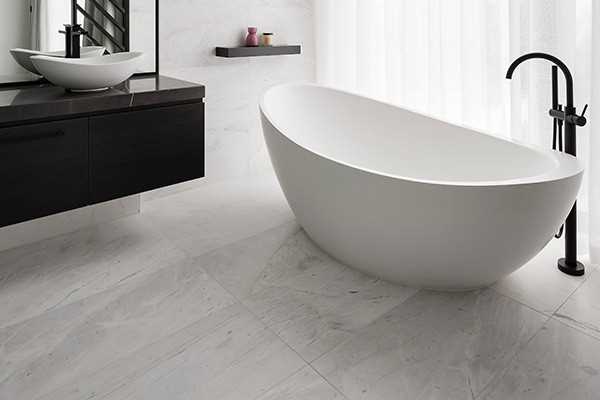
1. Soft Cleaning Cloth
One of the most essential tools for cleaning a freestanding bath is a soft cleaning cloth. This cloth should be gentle enough to avoid scratching the surface of the bath, while also being able to effectively remove dirt and grime.
2. Non-Abrasive Cleaner
Using a non-abrasive cleaner is crucial to prevent any damage to the surface of the freestanding bath. Look for a cleaner specifically designed for baths and showers that will effectively remove soap scum, mineral deposits, and other stains without scratching or dulling the finish.
3. Soft-Bristled Brush
In addition to a soft cleaning cloth, a soft-bristled brush can be a handy tool for scrubbing hard-to-reach or stubborn stains on the freestanding bath surface. Make sure the brush has soft bristles to avoid scratching the bath.
4. White Vinegar
White vinegar is a versatile and inexpensive product that can be used for cleaning various household surfaces, including a freestanding bath. Dilute some white vinegar with water and use it to remove stubborn stains or mineral deposits on the bath surface.
5. Toothbrush
A toothbrush can be a useful tool for cleaning small and intricate areas around the freestanding bath, such as the rim or corners. Choose a toothbrush with soft bristles that will not cause any damage to the bath surface.
6. Rubber Gloves
When using cleaning products, it is always a good idea to protect your hands with rubber gloves. This will not only prevent any skin irritation or chemical exposure but also provide a better grip while cleaning the freestanding bath.
7. Microfiber Towel
To achieve a streak-free finish after cleaning the freestanding bath, it is recommended to use a microfiber towel. These towels are highly absorbent and can effectively remove any excess moisture or cleaner residues from the bath surface.
8. Mild Soap
In addition to a non-abrasive cleaner, a mild soap can also be used for general cleaning of the freestanding bath. Opt for a gentle soap that will not leave any residue or film on the bath surface.
9. Plastic Spray Bottle
A plastic spray bottle can be a handy tool for mixing and applying cleaning solutions to the freestanding bath. It allows for precise application and even distribution of the cleaning product on the bath surface.
10. Enamel Repair Kit
If your freestanding bath has any chips or scratches on the surface, an enamel repair kit can help you fix these imperfections. Follow the manufacturer’s instructions carefully to ensure a proper repair.
11. Small Vacuum Cleaner
A small vacuum cleaner or handheld vacuum can be useful for removing any loose dirt or debris from around the freestanding bath before cleaning. This will make the cleaning process easier and more effective.
12. Water Softener
If you live in an area with hard water, using a water softener can help prevent the buildup of mineral deposits on the freestanding bath surface. This will make cleaning easier and reduce the frequency of deep cleaning required.
13. Lint-Free Cloth
A lint-free cloth can be used to dry and polish the freestanding bath after cleaning. This will help prevent any streaks or watermarks on the bath surface, leaving it looking shiny and clean.
14. Plastic Scraper
In case of any dried-on stains or residue on the freestanding bath, a plastic scraper can be used to gently scrape off the stubborn particles. Be cautious not to apply too much pressure to avoid scratching the bath surface.
By having these essential tools and products on hand, you’ll be well-equipped to keep your freestanding bath looking clean and beautiful. Remember to always follow the manufacturer’s instructions and test any new cleaning products on a small, inconspicuous area before using them on the entire bath surface.
Invest in Quality Supplies for Better Results
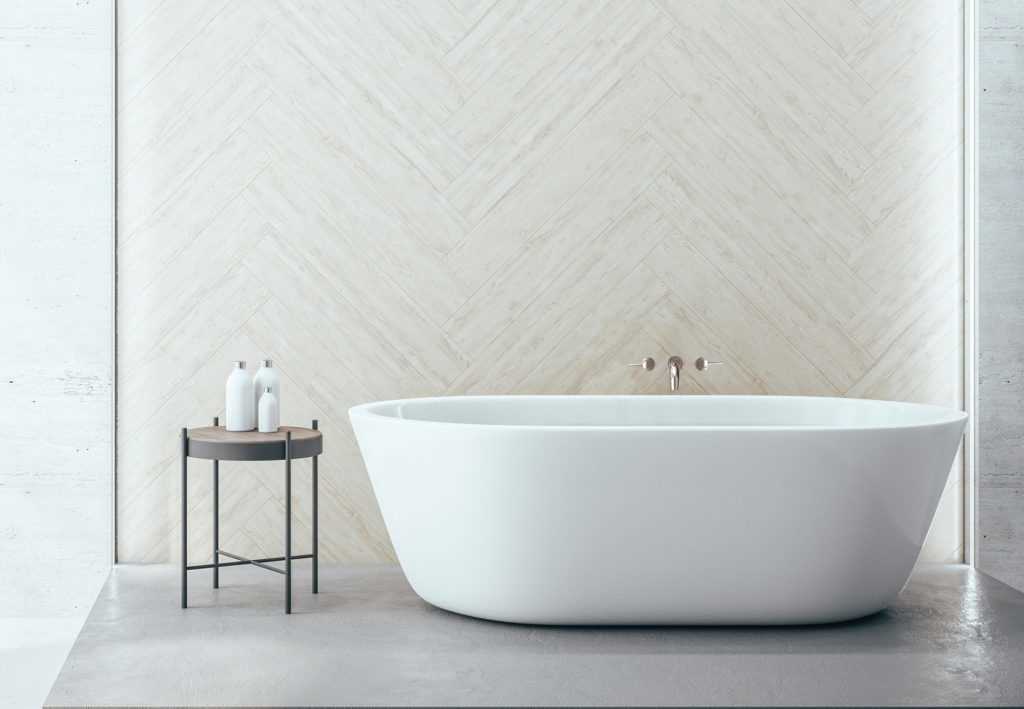
Cleaning a freestanding bath requires the use of specific cleaning supplies to ensure better results. Here are some essential supplies that you should consider investing in:
1. Non-abrasive cleaner
Choose a non-abrasive cleaner that is specifically designed for use on bathtubs. Avoid using harsh or abrasive cleaners as they can damage the surface of the bath. Look for a cleaner that is gentle yet effective in removing soap scum, grime, and stains.
2. Soft microfiber cloth
Invest in high-quality microfiber cloths that are soft and gentle on the bath’s surface. Avoid using rough materials like abrasive sponges or scrub brushes, as they can cause scratches or damage. Microfiber cloths are great for wiping down the bath and absorbing moisture quickly.
3. Long-handled brush
A long-handled brush will help you reach all the nooks and crannies of your freestanding bath, making it easier to clean hard-to-reach areas. Look for a brush with soft bristles that won’t scratch the surface of the bath.
4. Mild dish soap
Mild dish soap can be used as an alternative to commercial cleaners. It is gentle enough not to damage the surface of the freestanding bath but strong enough to remove grime and dirt effectively. Dilute a small amount of dish soap in warm water and use a cloth or sponge to clean the bath.
5. Vinegar
Vinegar is a natural cleaning agent that can effectively remove mineral deposits and soap scum from the bath’s surface. Mix equal parts of vinegar and water in a spray bottle, and spray it onto the bath. Let it sit for a few minutes, then wipe with a soft cloth or sponge.
6. Squeegee
A squeegee is a handy tool for removing excess water from the bath’s surface after cleaning. It helps prevent water spots and makes the bath look sparkling clean. Run the squeegee over the bath’s surface in long, even strokes to remove the water.
7. Mold and mildew remover
If you notice any mold or mildew growth in the bathroom, invest in a mold and mildew remover. Look for a product that is safe to use on the bath’s surface and effectively kills mold and mildew. Follow the manufacturer’s instructions for application and safety precautions.
By investing in quality cleaning supplies, you can ensure better results when cleaning around your freestanding bath. Remember to always follow the manufacturer’s instructions for using the cleaning products and take proper safety precautions.
Natural Cleaning Solutions for Freestanding Baths
1. Vinegar and Baking Soda
Mix equal parts of white vinegar and baking soda to create a paste. Apply the paste to the surface of the freestanding bath and let it sit for about 15 minutes. Scrub the bath with a soft brush or sponge to remove dirt and stains. Rinse thoroughly with water.
2. Lemon Juice
Squeeze fresh lemon juice onto a sponge or cloth and scrub the freestanding bath, focusing on areas with tough stains. Lemon juice acts as a natural bleach and can help remove stubborn stains. Rinse the bath with water after scrubbing.
3. Salt Scrub

Mix salt with a small amount of water to create a thick paste. Apply the paste to a cloth or sponge and gently scrub the surface of the bath. Salt is an effective abrasive that can help remove dirt and grime. Rinse thoroughly with water.
4. Essential Oils
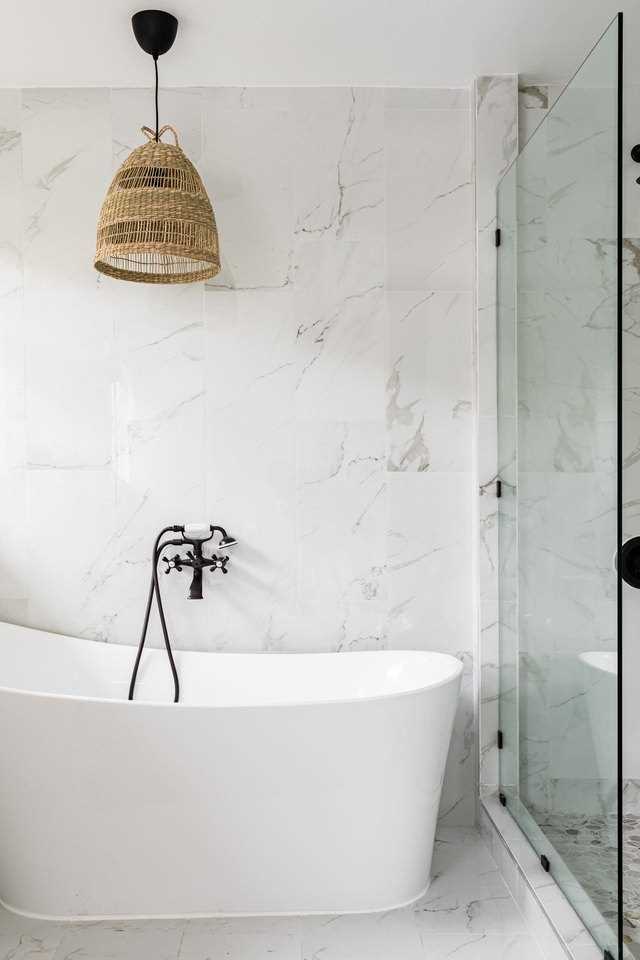
Add a few drops of your favorite essential oil to a bucket of warm water. Use a soft cloth or sponge soaked in the solution to clean the freestanding bath. Essential oils not only add a pleasant scent, but they also have antibacterial properties. Rinse the bath with clean water afterwards.
5. Hydrogen Peroxide
Dilute hydrogen peroxide with water in a 1:1 ratio. Apply the solution to the stained areas of the freestanding bath and let it sit for 10 minutes. Scrub the bath with a soft brush or sponge and rinse thoroughly with water. Hydrogen peroxide is a natural bleaching agent that can help remove tough stains.
6. Natural Soap
Use a mild, natural soap to clean the freestanding bath. Wet a cloth or sponge, lather with the soap, and scrub the bath. Rinse thoroughly with water. Avoid using harsh chemical cleaners as they can damage the surface of the bath.
7. Tea Tree Oil
Add a few drops of tea tree oil to a bucket of warm water. Use a cloth or sponge soaked in the solution to clean the freestanding bath. Tea tree oil has antimicrobial properties and can help kill bacteria. Rinse the bath with clean water afterwards.
By using these natural cleaning solutions, you can effectively clean your freestanding bath without exposing yourself or the environment to harmful chemicals. Always remember to test any cleaning solution on a small inconspicuous area of your bath before applying it to the entire surface.
FAQ
What are some easy tips for cleaning around a freestanding bath?
Some easy tips for cleaning around a freestanding bath include using a non-abrasive cleaner, regularly wiping down the bath with a soft cloth, and using a toothbrush or small brush to clean hard-to-reach areas.
What type of cleaner should I use to clean a freestanding bath?
It is best to use a non-abrasive cleaner specifically designed for use on baths. Avoid using harsh chemicals or abrasive cleaners, as they can damage the surface of the bath.
How often should I clean around a freestanding bath?
It is recommended to clean around a freestanding bath at least once a week to prevent buildup of dirt and grime. However, if the bath is used frequently, it may be necessary to clean it more often.
Can I use bleach to clean a freestanding bath?
No, it is not recommended to use bleach to clean a freestanding bath. Bleach is a harsh chemical that can damage the surface of the bath. It is best to use a non-abrasive cleaner specifically designed for use on baths.
What should I do if there is stubborn dirt or stains on a freestanding bath?
If there are stubborn dirt or stains on a freestanding bath, you can try using a gentle, non-abrasive cleaner and a soft cloth or sponge to scrub the area. If the stains persist, you may need to seek professional help or use specialized cleaning products.
How can I prevent limescale buildup around a freestanding bath?
To prevent limescale buildup around a freestanding bath, you can regularly wipe down the bath with a soft cloth or sponge after each use. Additionally, using a descaler or a mixture of white vinegar and water can help remove any existing limescale deposits.
Is there anything I should avoid when cleaning a freestanding bath?
Yes, there are a few things to avoid when cleaning a freestanding bath. Avoid using abrasive cleaners or harsh chemicals, as they can damage the surface of the bath. Additionally, avoid using abrasive scrub brushes or steel wool, as they can leave scratches.



